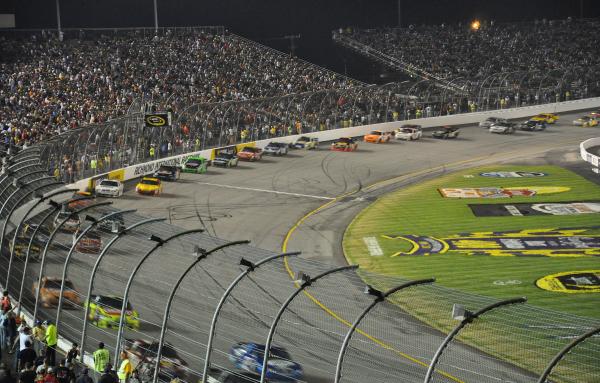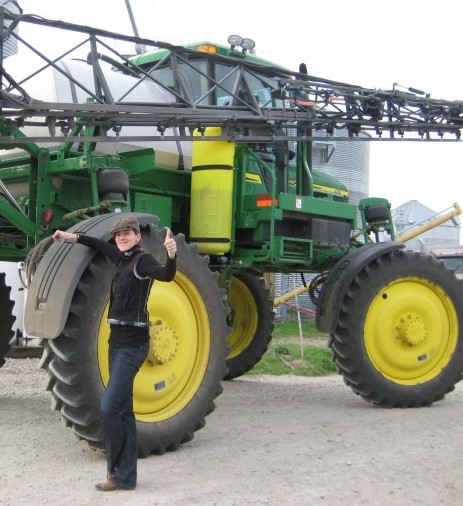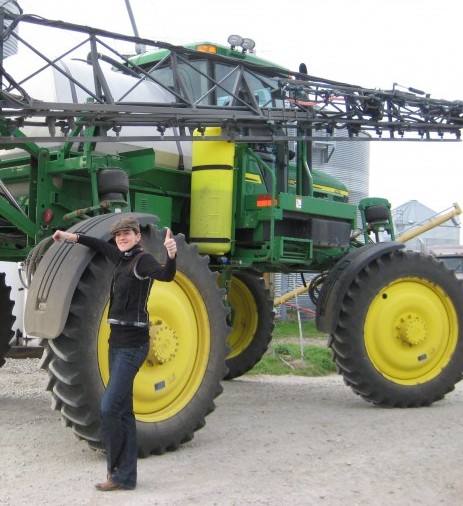 Amanda Little on the farm.
Amanda Little on the farm.
If you pinned a map of the United States to a dartboard, Kansas would be the bull’s-eye. Smack dab in the center of the country, the Sunflower State is one of America’s most productive agricultural hotbeds — the fifth-biggest producer of crops and livestock in the country. More than 90 percent of the state consists of farmland endowed thousands of years ago with rich glacial loam. This fertile topsoil is no longer as robust as it once was, having offered up its nutrients season after season, decade after decade, century after century, to produce great bounties of wheat, corn, soybeans, sorghum, hay, and sunflowers. I could almost sense the exhaustion of the land as I drove through the back roads of northeastern Kansas one chilly November morning — past sagging wooden farmhouses silvered by age and weather, barbed-wire fences with listing wooden posts, general stores and swinging-door saloons, a Native American heritage museum commemorating the Kansa tribes that once roamed and tilled these prairies, and mile after desolate mile of denuded farmland.
It wasn’t that this dormant soil was incapable of producing — on the contrary, during the previous summer and fall it had yielded one of the most plentiful harvests in Kansas history, many times greater than the bounty of a century earlier, when the land was more inherently fertile. But now, like an aging bull receiving shots of testosterone, this well-worn ground reaps the benefits of modern chemistry — and good old-fashioned fossil fuels.
That late fall morning, thousands of tractors combed the Kansas countryside, priming the soil for next spring’s planting with a “booster shot” of nutrients that would turn the weary earth into some of the world’s highest-producing farmland. That chemical nourishment, also known as fertilizer, has transformed America’s economy over the last century, and expanded the global population, too, by vastly increasing the food supply.
Nitrogen, potassium, and phosphorous are the three most common nutrients in the fertilizers applied to American farmlands, nitrogen being by far the most prevalent. The main form of nitrogen fertilizer is known as anhydrous ammonia, and natural gas is its primary feedstock. Nitrogen fertilizers take many forms, ranging from the Miracle-Gro sold at your local Home Depot to the industrial-strength anhydrous ammonia that’s used on tens of millions of acres of U.S. corn and wheat crops. Each year, American farmers apply 6.2 billion pounds of fossil-fuel-based fertilizers to their croplands.
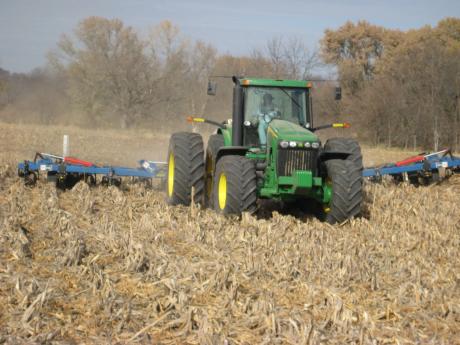 Ken McCauley’s corn fields getting their booster shots.
Ken McCauley’s corn fields getting their booster shots.
To see fossil fuels in action on the farm, I paid a visit to Kansas corn grower Ken McCauley. His vast tracts of land—rolling stretches of bone-colored soil—reminded me of nothing so much as the ocean with their sheer expanse.
To distribute his fertilizer, Ken hitched a 2.2-ton canister of nitrogen to the back of his apple-green John Deere tractor. A series of tubes and wires connected the tractor and fertilizer tank to a mechanism that looked like a giant rake spanning eight rows of corn. The dozens of prongs at the end of the rake were tipped with knifelike cutters that would pierce into the soil, opening it up so that hoses embedded within the blades could blast the chemical nutrients six inches into the ground. The liquid fertilizer freezes into golf ball–sized lumps in the wintertime that then thaw and release into the soil in the spring. It’s best to inject the fertilizer in the late fall or early winter, Ken explained, so that the soil doesn’t have to be opened up in the spring, which would release precious moisture.
I climbed up into a plush passenger seat in the tractor cab next to Ken’s foreman, Nick James. Though the seats were mounted on shock absorbers, they still bounced and pitched as we trundled over the rough, hilly ground. I grabbed the dash to steady myself as we began to move slowly down the field.
Maneuvering a tractor throughout a cornfield is a little like steering a ship through waves — it’s hard to keep the vessel in a straight line on the sloping, bumpy earth and then to repeat that straight line exactly as you traverse the rest of the field, without overlapping any areas on which you’ve already sprayed nitrogen. Conventional tractors routinely overlap on fertilizer application, wasting precious resources. Ken is able to overcome this costly human error because his tractor drives itself. “See the GPS system?” Nick asked, pointing to a small round blinking device on the dashboard. That device was feeding signals to a satellite monitoring the position of the tractor on the field. The satellite was then automatically feeding those location coordinates into an autopilot system that steers the tractor on a precise course, never double-applying fertilizer to the same patch of soil.
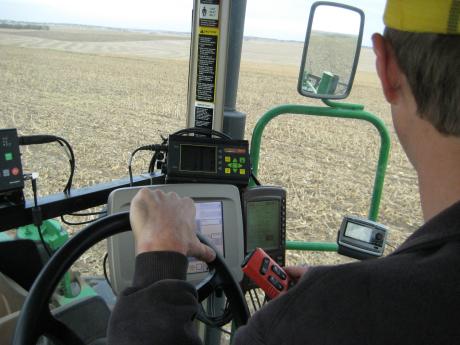 This tractor is high-tech.
This tractor is high-tech.
Ken’s tractor is also outfitted with new computer software that enables him to vary the distribution of nutrients according to soil quality. Ken estimates that about 10 to 15 percent of the fertilizers applied on U.S. farms actually go to waste because they’re blindly doused on areas of soil that in fact have sufficient levels of nitrogen. Other agriculture experts I interviewed put that number even higher, saying that up to 35 percent of the nitrogen typically sprayed on farmland goes to waste, draining out of the soil and polluting nearby bodies of water.
As natural gas and oil prices surged in recent years, the costs of fertilizers nearly quadrupled. In 2005, when natural gas prices were low, a 2.2-ton tank of anhydrous ammonia cost under $400. When gas prices shot up in 2008, that same tank of fertilizer cost nearly $2,000. To fertilize Ken’s 4,000 acres, that added up to an expense of roughly $500,000 a year — about 40 percent of his total operating costs of $1.2 million a year. Even with soaring costs, he explained, “fertilizer is the most economical thing we do because it gives you your production on the top end.” In other words, while Ken spent nearly half a million dollars on fertilizers in 2008, these additives still created significantly more value in enhanced crop production.
What would happen if Ken cut out chemical fertilizers altogether? “If you don’t put your fertilizer on,” he told me, “you’ll cut your yields by half or more. No farmer is going to stop using nitrogen altogether. Look at the poor countries — when you travel to places that don’t use the fertilizer you’ll see they’re raising a third of the yield.” He boiled the issue down to six words: “Nitrogen is yield. Yield is nitrogen.” And yield, he added, is everything. “Worst thing that can happen to a farmer is getting a reputation for having a low yield. It’s like being a race car with a lawnmower engine or a newspaper that’s always a week behind.”
Sustainable farming advocates such as author Michael Pollan put forth a different vision for agriculture in America: total reform of the food system, beginning with the dismantling of large single-crop farms and the end of fossil fuel–based inputs. They argue that farmland can be naturally replenished through farming practices including the application of animal manure, which is high in nitrogen. Pollan describes a virtuous cycle of nutrient recycling between crops and animals:
Sunlight nourishes the grasses and grains, the plants nourish the animals, the animals then nourish the soil, which in turn nourishes the next season’s grasses and grains. Animals on pasture can also harvest their own feed and dispose of their own waste–all without help of fossil fuel.
But, he maintains, simply removing fertilizers and other petrochemical additives from industrial farming is not the whole answer: “Only a fifth of the total energy used to feed us is consumed on the farm; the rest is spent processing the food and moving it around,” Pollan wrote in his book The Omnivore’s Dilemma. For that reason, he added, the large-scale organic farms that produce most of the organic products in your grocery store are, just like conventional megafarms, “floating on a sinking sea of petroleum.”
Reformers want to see a network of small and midsized organic farms that is organized into regional cooperatives. These aggregates would enable small farms to serve local markets but think like big farms, working together to make bulk purchases of equipment and aggregate distribution systems. They want to see crops and animals reintegrated into the same farms, naturally feeding and fertilizing one another, correcting the current system in which cattle, chickens, and pigs are concentrated on huge feedlots, producing an oversupply of nitrogen-rich manure far removed from croplands.
On the other hand, most agronomists will tell you that we can’t rapidly shift to growing food on a global level without chemical fertilizer and fossil fuel–powered machinery. The United Nations has predicted an increase in fertilizer use worldwide of roughly 35 percent by 2030. Jeffrey Sachs, the United Nations special advisor who wrote The End of Poverty, told me plainly that fertilizers will be necessary to human survival for the foreseeable future: “We will not feed 6.7 billion people on the planet without chemical fertilizers.” On weathered tropical soils like those of farmlands in large portions of Africa, says Sachs, fertilizers will play a key role. “In all the world but Africa, farmers are using around 100 kilograms per hectare on average of fertilizer. In Africa it’s essentially zero, which is one of the real reasons for the massive hunger there.”
Perhaps the challenge, then, is not so much to go cold turkey on modern farming methods as it is to significantly improve methods for getting the greatest amount of food production using the least amount of fuel and fertilizer. With the world’s population poised to hit 7 billion by 2012, we can’t get started soon enough.
This piece was excerpted from Amanda Little’s book Power Trip: From Oil Wells to Solar Cells—Our Ride to the Renewable Future.
